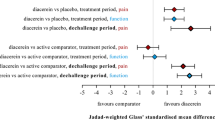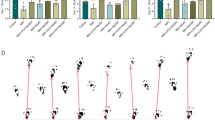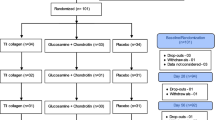Abstract
Background and aim: Because in vitro studies have shown that nimesulide not only preferentially inhibits COX-2 but also reduces the action/release of pro-inflammatory cytokines, down-regulates the synthesis and/or activity of collagenase(s), and releases reactive oxygen species and other toxic substances from neutrophils, this study investigated whether nimesulide and ibuprofen could affect levels of biochemical markers of joint inflammation and collagen catabolism in patients with flare-up of knee or hip osteoarthritis.
Methods: Ninety patients were included in this randomised, prospective, singleblind study. They received either nimesulide (n = 45) or ibuprofen (n = 45) for a 4-week treatment period. The following parameters were analysed by ELISA: urinary levels of C-terminal cross-linking telopeptide of type II collagen (CTX-II), a marker of type II collagen breakdown; serum levels of hyaluronan (HA), a marker of synovial inflammation and hyperplasia; and circulating levels of stromelysin-1 (matrix metalloproteinase-3 [MMP-3]), collagenase-1 (MMP-1) and collagenase-3 (MMP-13). Statistical analysis used was ANOVA.
Results: At the end of the treatment period, nimesulide but not ibuprofen markedly reduced the urinary levels of CTX-II (p < 0.001) and the serum levels of HA (p < 0.05), two markers known to prognosticate poor outcome of the osteoarthritis disease process. Nimesulide also reduced the serum levels of both MMP-3 (p < 0.05) and MMP-13 (p < 0.001). Furthermore, in the nimesulide group, the decrease in levels of CTX-II correlated significantly with the decrease in levels of HA and MMP-13.
Conclusion: Although nonsteroidal anti-inflammatory drugs are effective in improving pain and disability in OA patients, to date it has been unclear to what extent these drugs could affect joint metabolism and hence joint structure. Patients with flare-up of their osteoarthritis disease process exhibit enhanced levels of markers of joint inflammation and cartilage collagen breakdown, which were markedly decreased by nimesulide but not by ibuprofen.




Similar content being viewed by others
References
Poole AR, Nelson F, Dahlberg L, et al. Proteolysis of the collagen fibril in osteoarthritis. Biochem Soc Symp 2003; (70): 115–23
Caterson B, Flannery CR, Hughes CE, et al. Mechanisms involved in cartilage proteoglycan catabolism. Matrix Biol 2000; 19: 333–44
Little CB, Hughes CE, Curtis CL, et al. Matrix metalloproteinases are involved in C-terminal and interglobular domain processing of cartilage aggrecan in late stage cartilage degradation. Matrix Biol 2002; 21: 271–88
Tiku ML, Gupta S, Deshmukh DR. Aggrecan degradation in chondrocytes is mediated by reactive oxygen species and protected by antioxidants. Free Radic Res 1999; 30: 395–405
Tiku ML, Shah R, Allison GT. Evidence linking chondrocyte lipid peroxidation to cartilage matrix protein degradation: possible role in cartilage aging and the pathogenesis of osteoarthritis. J Biol Chem 2000; 275: 20069–76
Henrotin YE, Bruckner P, Pujol JP. The role of reactive oxygen species in homeostasis and degradation of cartilage. Osteoarthritis Cartilage 2003; 11: 747–55
Smith MD, Triantafillou S, Parker A, et al. Synovial membrane inflammation and cytokine production in patients with early osteoarthritis. J Rheumatol 1997; 24: 365–71
Van den Berg WB, van der Kraan PM, van Beuringen HM. Synovial mediators of cartilage damage and repair In: Brandt KD, Doherty M, Lohmander LS, editors. Osteoarthritis. Oxford: University Press, 2003: 147–155
Ayral X, Pickering EH, Woodworth TG, et al. Synovitis: a potential predictive factor of structural progression of medial tibiofemoral knee osteoarthritis: results of a 1 year longitudinal arthroscopic study in 422 patients. Osteoarthritis Cartilage 2005; 13: 361–7
Sharif M, George E, Shepstone L, et al. Serum hyaluronic acid level as a predictor of disease progression in osteoarthritis of the knee. Arthritis Rheum 1995; 38: 760–7
Spector TD, Hart DJ, Nandra D, et al. Low-level increases in serum C-reactive protein are present in early osteoarthritis of the knee and predict progressive disease. Arthritis Rheum 1997; 40: 723–7
Amin AR, Attur M, Patel RN, et al. Superinduction of cyclo-oxygenase-2 activity in human osteoarthritis-affected cartilage: influence of nitric oxide. J Clin Invest 1997; 99: 1231–7
Dubois RN, Abramson SB, Crofford L, et al. Cyclooxygenase in biology and disease. FASEB J 1998; 12: 1063–73
Pelletier JP, Martel-Pelletier J. Effects of nimesulide and naproxen on the degradation and metalloprotease synthesis of human osteoarthritic cartilage. Drugs 1993; 46 Suppl. 1: 34–9
Rainsford KD. Relationship of nimesulide safety to its pharmacokinetics: assessment of adverse reactions. Rheumatology (Oxford) 1999; 38 Suppl. 1: 4–10
Yamazaki R, Kawai S, Mizushima Y, et al. A major metabolite of aceclofenac, 4’-hydroxy aceclofenac, suppresses the production of interstitial pro-collagenase/proMMP-1 and prostromelysin-1/proMMP-3 by human rheumatoid synovial cells. Inflamm Res 2000; 49: 133–8
Sadowski T, Steinmeyer J. Effects of non-steroidal anti-inflammatory drugs and dexamethasone on the activity and expression of matrix metalloproteinase-1, matrix metalloproteinase-3 and tissue inhibitor of metalloproteinases-1 by bovine articular chondrocytes. Osteoarthritis Cartilage 2001; 9: 407–15
Sanchez C, Mateus MM, Defresne MP, et al. Metabolism of human articular chondrocytes cultured in alginate beads: long term effects of interleukin 1beta and nonsteroidal antiinflammatory drugs. J Rheumatol 2002; 29: 772–82
Rainsford KD. Discovery, mechanisms of action and safety of ibuprofen. Int J Clin Pract Suppl 2003; (135): 3–8
Yoon JB, Kim SJ, Hwang SG, et al. Non-steroidal anti-inflammatory drugs inhibit nitric oxide-induced apoptosis and dedifferentiation of articular chondrocytes independent of cyclo-oxygenase activity. J Biol Chem 2003; 278: 15319–25
Howell DS, Pita JC, Muller FJ, et al. Treatment of osteoarthritis with tiaprofenic acid: biochemical and histological protection against cartilage breakdown in the Pond-Nuki canine model. J Rheumatol Suppl 1991; 27: 138–42
Brandt KD. Should osteoarthritis be treated with nonsteroidal anti-inflammatory drugs? Rheum Dis Clin North Am 1993; 19: 697–712
Huskisson EC, Berry H, Gishen P, et al. Effects of antiinflammatory drugs on the progression of osteoarthritis of the knee. LINK Study Group. Longitudinal Investigation of Nonsteroidal Antiinflammatory Drugs in Knee Osteoarthritis. J Rheumatol 1995; 22: 1941–6
Dingle JT. The effect of nonsteroidal antiinflammatory drugs on human articular cartilage glycosaminoglycan synthesis. Osteoarthritis Cartilage 1999; 7: 313–4
Blot L, Marcelis A, Devogelaer JP, et al. Effects of diclofenac, aceclofenac and meloxicam on the metabolism of proteoglycans and hyaluronan in osteoarthritic human cartilage. Br J Pharmacol 2000; 131: 1413–21
Ding C. Do NSAIDs affect the progression of osteoarthritis? Inflammation 2002; 26: 139–42
El Hajjaji H, Marcelis A, Devogelaer JP, et al. Celecoxib has a positive effect on the overall metabolism of hyaluronan and proteoglycans in human osteoarthritic cartilage. J Rheumatol 2003; 30: 2444–51
Gineyts E, Mo JA, Ko A, et al. Effects of ibuprofen on molecular markers of cartilage and synovium turnover in patients with knee osteoarthritis. Ann Rheum Dis 2004; 63: 857–61
Ravaud P, Giraudeau B, Auleley GR, et al. Variability in knee radiographing: implication for definition of radiological progression in medial knee osteoarthritis. Ann Rheum Dis 1998; 57: 624–9
Schiller J, Huster D, Fuchs B, et al. Evaluation of cartilage composition and degradation by high-resolution magic-angle spinning nuclear magnetic resonance. Methods Mol Med 2004; 101: 267–85
Manicourt DH, Fujimoto N, Obata K, et al. Serum levels of collagenase, stromelysin-1, and TIMP-1: age- and sex-related differences in normal subjects and relationship to the extent of joint involvement and serum levels of antigenic keratan sulfate in patients with osteoarthritis. Arthritis Rheum 1994; 37: 1774–83
Thonar EJM, Lenz ME, Masuda K, et al. Body fluid markers of cartilage metabolism. In: Seibel MJ, Robins SP, Bilezikian JP, editors. Dynamics of bone and cartilage metabolism. San Diego: Academic Press, 1999: 453–64
Manicourt DH, Poilvache P, Nzeusseu A, et al. Serum levels of hyaluronan, antigenic keratan sulfate, matrix metalloproteinase 3, and tissue inhibitor of metalloproteinases 1 change predictably in rheumatoid arthritis patients who have begun activity after a night of bed rest. Arthritis Rheum 1999; 42: 1861–9
Yoshihara Y, Nakamura H, Obata K, et al. Matrix metalloproteinases and tissue inhibitors of metalloproteinases in synovial fluids from patients with rheumatoid arthritis or osteoarthritis. Ann Rheum Dis 2000; 59: 455–61
Christgau S, Garnero P, Fledelius C, et al. Collagen type II C-telopeptide fragments as an index of cartilage degradation. Bone 2001; 29: 209–15
Garnero P, Piperno M, Gineyts E, et al. Cross sectional evaluation of biochemical markers of bone, cartilage, and synovial tissue metabolism in patients with knee osteoarthritis: relations with disease activity and joint damage. Ann Rheum Dis 2001; 60: 619–26
Garnero P, Gineyts E, Christgau S, et al. Association of baseline levels of urinary glucosyl-galactosyl-pyridinoline and type II collagen C-telopeptide with progression of joint destruction in patients with early rheumatoid arthritis. Arthritis Rheum 2002; 46: 21–30
Ottonello L, Dapino P, Pastorino G, et al. Nimesulide as a downregulator of the activity of the neutrophil myeloperoxidase pathway: focus on the histoprotective potential of the drug during inflammatory processes. Drugs 1993; 46 Suppl. 1: 29–33
Barracchini A, Franceschini N, Amicosante G, et al. Can nonsteroidal anti-inflammatory drugs act as metalloproteinase modulators? An in-vitro study of inhibition of collagenase activity. J Pharm Pharmacol 1998; 50: 1417–23
Famaey JP. In vitro and in vivo pharmacological evidence of selective cyclooxygenase-2 inhibition by nimesulide: an overview. Inflamm Res 1997; 46: 437–46
Bennett A, Villa G. Nimesulide: an NSAID that preferentially inhibits COX-2, and has various unique pharmacological activities. Expert Opin Pharmacother 2000; 1: 277–86
Kellgren JH, Lawrence JS. Radiological assessment of osteoarthrosis. Ann Rheum Dis 1957; 16: 494–502
McCrae F, Shouls J, Dieppe P, et al. Scintigraphic assessment of osteoarthritis of the knee joint. Ann Rheum Dis 1992; 51: 938–42
Insel PA. Analgesic-antipyretics and anti-inflammatory agents. In: Goodman Gilman A, Rall TW, Nies AS, et al., editors. The pharmacological basis of therapeutics. Singapore: McGraw-Hill, 1992: 638–81
De Brabander C, Vervaet C, Gortz JP, et al. Bioavailability of ibuprofen from matrix mini-tablets based on a mixture of starch and microcrystalline wax. Int J Pharm 2000; 208: 81–6
Bernareggi A. The pharmacokinetic profile of nimesulide in healthy volunteers. Drugs 1993; 46 Suppl. 1: 64–72
Saag K, van der Heijde D, Fisher C, et al. Rofecoxib, a new cyclooxygenase 2 inhibitor, shows sustained efficacy, comparable with other nonsteroidal anti-inflammatory drugs: a 6-week and a 1-year trial in patients with osteoarthritis. Osteoarthritis Studies Group. Arch Fam Med 2000; 9: 1124–34
Myers SL, Brandt KD, Eilam O. Even low-grade synovitis significantly accelerates the clearance of protein from the canine knee. Implications for measurement of synovial fluid ‘markers’ of osteoarthritis. Arthritis Rheum 1995; 38: 1085–91
Passmore AP, Copeland S, Johnston GD. A comparison of the effects of ibuprofen and indomethacin upon renal haemodynamics and electrolyte excretion in the presence and absence of frusemide. Br J Clin Pharmacol 1989; 27: 483–90
Freemont AJ, Byers RJ, Taiwo YO, et al. In situ zymographic localisation of type II collagen degrading activity in osteoarthritic human articular cartilage. Ann Rheum Dis 1999; 58: 357–65
Kullich WC, Niksic F, Klein G. Effect of nimesulide on metalloproteinases and matrix degradation in osteoarthritis: a pilot clinical study. Int J Clin Pract Suppl 2002; 128: 24–9
Meyer FA, Yaron I, Mashiah V, et al. Effect of diclofenac on prostaglandin E and hyaluronic acid production by human synovial fibroblasts stimulated with interleukin-1. Br J Clin Pharmacol 1989; 28: 193–6
Shield MJ, Dingle J. Co-stimulatory effects of misoprostol and diclofenac on glycosaminoglycan synthesis in human cartilage explants and their therapeutic relevance. Am J Ther 1996; 3: 195–203
Smith RL, Kajiyama G, Lane NE. Nonsteroidal antiinflammatory drugs: effects on normal and interleukin 1 treated human articular chondrocyte metabolism in vitro. J Rheumatol 1995; 22: 1130–7
Ottonello L, Dapino P, Pastorino G, et al. Nimesulide as a downregulator of the activity of the neutrophil myeloperoxidase pathway: focus on the histoprotective potential of the drug during inflammatory processes. Drugs 1993; 46 Suppl. 1: 29–33
Facino RM, Carini M, Aldini G. Antioxidant activity of nimesulide and its main metabolites. Drugs 1993; 46 Suppl. 1: 15–21
Saari H, Sorsa T, Lindy O, et al. Reactive oxygen species as regulators of human neutrophil and fibroblast interstitial collagenases. Int J Tissue React 1992; 14 (3): 113–20
Saari H, Konttinen YT, Friman C, et al. Differential effects of reactive oxygen species on native synovial fluid and purified human umbilical cord hyaluronate. Inflammation 1993; 17: 403–15
Noble PW. Hyaluronan and its catabolic products in tissue injury and repair. Matrix Biol 2002; 21: 25–9
Vincenti MP, Brinckerhoff CE. Transcriptional regulation of collagenase (MMP-1, MMP-13) genes in arthritis: integration of complex signaling pathways for the recruitment of gene-specific transcription factors. Arthritis Res 2002; 4: 157–64
Acknowledgements
There was no external funding for this article, and the authors have no potential conflicts of interest that are directly relevant to the contents of this article.
Author information
Authors and Affiliations
Corresponding author
Rights and permissions
About this article
Cite this article
Manicourt, DH., Bevilacqua, M., Righini, V. et al. Comparative Effect of Nimesulide and Ibuprofen on the Urinary Levels of Collagen Type II C-Telopeptide Degradation Products and on the Serum Levels of Hyaluronan and Matrix Metalloproteinases-3 and -13 in Patients with Flare-Up of Osteoarthritis. Drugs R D 6, 261–271 (2005). https://doi.org/10.2165/00126839-200506050-00002
Published:
Issue Date:
DOI: https://doi.org/10.2165/00126839-200506050-00002




